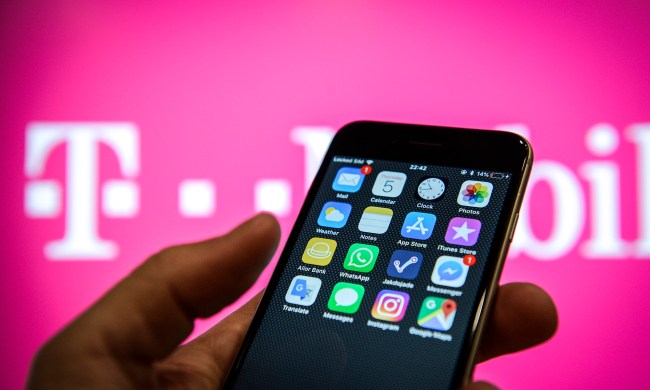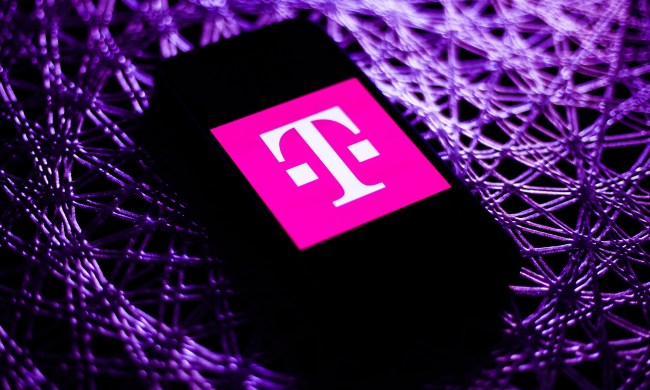“It's a step up from the G1, but for non-T-Mobile customers there are superior touch-screen smartphone choices...”
- Android operating system; beautiful 3.2-inch HVGA touchscreen; expandable memory; physical control buttons; lightweight
- No 3.5mm headphone jack; no built-in memory; slow 3G Web connectivity; minimal T-Mobile 3G coverage
Summary
Warning: This review is not as in-depth as we would like, so we will be updating it when we can. We got a chance to fiddle with the second-ever U.S. Android phone, the T-Mobile myTouch 3G made by HTC, for around 45 minutes at an introductory event yesterday. The myTouch became available for pre-order to current T-Mobile subscribers Wednesday, and will be available to all August 5 for at $199.99 (with a two-year service contract). Our initial quick-take verdict? This sleek, lightweight touchscreen smartphone offers several improvements to its predecessor, the G1. But one major similarity to the G1 and a third Android phone due later this year may keep many potential T-Mobile customers from touching myTouch.

How does the myTouch compare to the iPhone and the Pre?” Not well, at least in terms of value.
The MyTouch 3G, like the G1, has minimal on-board memory, but it comes with a 4GB microSD card installed. For the same $200, the Pre gives you 8GB inside, the iPhone 16GB, and a bigger screen. True, neither of these competitors has a memory expansion slot, but a 16GB card will run you an extra $50 or more. Once 32 GB cards become widely available, the myTouch may actually enjoy a longer life than the Pre or iPhone.
But there’s a problem with T-Mobile’s 3G network. You’ll need a magnifying glass to find the dark teal splotches that represent 3G network availability on the T-Mobile coverage map.
Still, Google’s Android operating system works in the phone’s favor. It’s arguably the best mobile OS. Like Palm OS, Android can multitask, and, unlike the iPhone, Android lets you create home page folders so you can intelligently group apps.
The phone’s beautiful 3.2-inch HVGA screen is also a plus. Pictures and especially text look crisply rendered, almost as if they were finely printed on glossy stock paper.
Otherwise, the myTouch compares favorably feature-wise with its two main rivals: a 3.2 MP camera, Wi-Fi, full HTML Web browser, music player, stereo Bluetooth, A-GPS, POP3/IMAP/Microsoft Exchange email, IM, and voice dialing.
The myTouch also comes with several programs pre-installed. Along with several Google apps, there’s the clever Sherpa, a location-based app that automatically locates all local businesses and services in your immediate GPS area, grouping them in the usual GPS navigation categories. It’s one of those “why didn’t I think of that?” ideas that’s sure to be a big hit, especially if it becomes available on other devices.

Physically, the myTouch fits between the Pre and the larger iPhone, and weighs 0.7 ounces less than both. The weight savings are achieved by eliminating the physical slide-out keyboard. The myTouch is made from smooth pebble plastic, with a perimeter is unmarred by slots and control keys. You’ll find only a volume toggle on myTouch’s left side, and a USB jack at the bottom – and therein lies myTouch’s Achilles heel.
Ports & Connectors
There’s no 3.5mm headphone jack. You have to use the included USB-to-3.5mm adapter to listen with anything but the myTouch’s own USB-terminated earbuds.
This omission is nearly unforgiveable, given the criticism the G1 received for the same blunder. HTC acknowledged (at least to us) that not including a 3.5mm jack on the G1 was a mistake, that would be remedied on its next Android device, and that nearly all 3G touchscreen smartphones include a 3.5mm headphone jack. We were told aesthetic priorities trumped this enormously functional consideration. For us, that’s a devil’s bargain and, combined with T-Mobile’s penurious 3G network, a deal breaker.

The echoy room in which we fiddled with the myTouch was filled with other noisy media types conducting their own demos, making it impossible to judge the quality of the sound. We did get enough volume, even in that raucous environment, to discern what was being said to us from the other end of the call, however.
Phone Functionality
T-Mobile’s myTouch has the usual Android array of physical controls on the front under the screen: the send/end keys along with home, menu and back keys, and a nipple track ball. While these keep the myTouch from attaining the MOMA-like minimalism of the iPhone or Pre, their utility thankfully outweighed the form factor considerations.
You get both a widescreen and portrait keyboard for all text-input programs, such as IM and email. Like the iPhone, there is no haptic feedback. We found typing quite easy, although the keyboard didn’t seem as touch sensitive as the iPhone’s. We often had to go back and insert spaces and carriage returns that the phone failed to register on our initial touches. Otherwise, we made few mistakes, as our fingers flew increasingly furiously over the touch keys.
Web
Web surfing was S-L-O-W! But access may have been hampered by the number of 3G users in the room. The mobile CNN.com site took seven to eihht seconds to load, compared to around 5 seconds on the iPhone and Pre. ESPN’s mobile page took around 10 seconds to load, and the full New York Times page took nearly 30 seconds – 10 seconds more than on the iPhone.

We took some photos at the event, but the demo phone was tethered, so we were unable to give the camera a fair testing. Judge camera quality for yourself from the shots we could take. Oddly, the viewfinder showed a fuzzier image than what was actually captured.
Battery Life
T-Mobile rates the myTouch at 600 hours (25 days) in standby, and 6 hours of talk time.
Conclusion
The myTouch isn’t a bad phone, it’s just puzzling, especially considering that the third HTC Android phone, the Hero, is due in the U.S. a little later this year. (Although HTC has declined to say which GSM carrier will be selling it.) With a 5-megapixel camera, Adobe Flash compatability, a gravity sensor, and a 3.5mm headphone jack, the Hero is a clearly superior phone. On paper, it’s even superior to the iPhone – and probably the phone the myTouch could or should have been. For T-Mobile customers, it’s definitely a step up from the awkward G1, but for non-T-Mobile customers, both the iPhone and the Pre, with their wider 3G availability, more on-board memory, and 3.5mm headphone jacks, are superior touch-screen smartphone choices.
Pros:
- Android operating system
- Beautiful 3.2-inch HVGA touchscreen
- Expandable memory
- Physical control buttons
- Lightweight
Cons:
- No 3.5mm headphone jack
- No built-in memory
- Slow 3G Web connectivity
- Minimal T-Mobile 3G coverage

